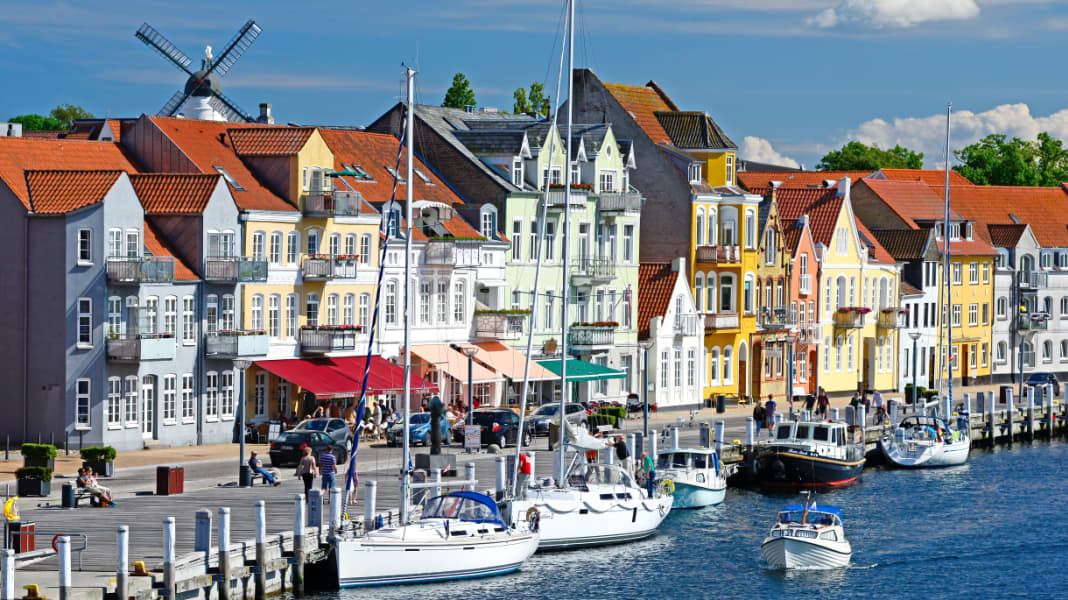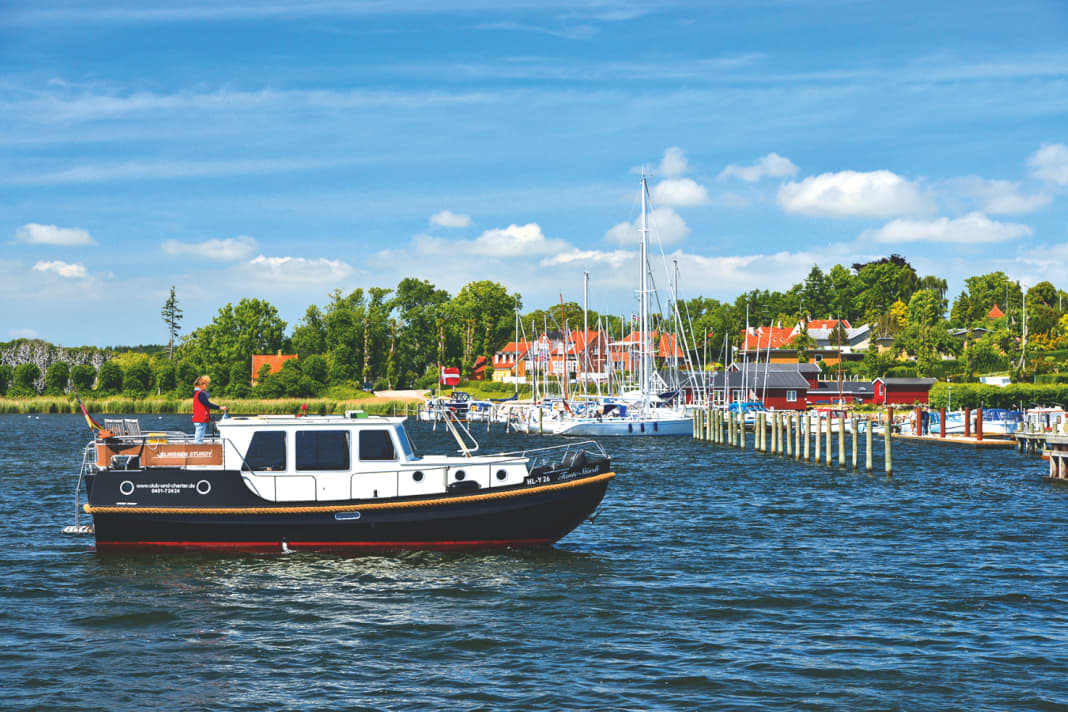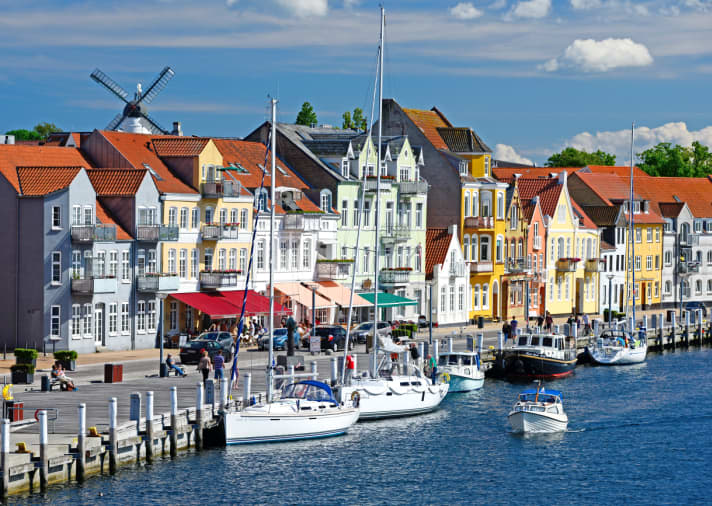







The Baltic Sea lies before us as smooth as a mirror. Not a breath of wind. But plenty of sunshine. On a Sunday afternoon in June, we picked up our charter boat in Burgtiefe on Fehmarn and stocked up on provisions. At 6.40 pm we are ready to go. We are heading across the Baltic Sea to the "Danish South Sea".
You won't find this term on land or sea charts or in geographical reference books. In Danish there is only the term Sydfynske Øhav (South Funen Archipelago) to describe the island world south of Funen. And in the Danish maritime language there is the (also unofficial) term Dansk Sydhav (Danish Southern Sea).
The term "Danish South Sea", on the other hand, only exists here. It was introduced and popularised by German sailors from the Baltic Sea, who at some point discovered the nearby "South Sea" for themselves. The assumption derived from this that the sun shines particularly abundantly there is completely wrong - far from it! In fact, in purely statistical terms, there is even less sunshine than in Copenhagen or on Bornholm. On the other hand, it rains more than in other parts of Denmark. And yet the Danish South Sea must have its charms. Looking at the map, we assume that it stretches between the islands of Als, Ærø, Langeland, Lolland, Falster and Møn.
The weather in the evening is simply far too good to stay in the harbour. So we decide to cast off and cross the Baltic Sea during the night. With the glistening June sun on our faces, we head westwards on the Fehmarn Sound. Shortly after 8 p.m. we have the Flügge lighthouse on our starboard side and say goodbye to Fehmarn. We change our course to north-west and now aim for the southern tip of Langeland. It is about 23 nautical miles from here to Bagenkop, the southernmost harbour on the Danish island.
We leave the sheltered waters of the Fehmarn Sound and head out into the open sea. It's not quite so calm here. There is a light north-westerly wind of two to three Beaufort, and the usual short Baltic Sea wave rolls right up against us. But our Linssen Sturdy, which is almost eleven metres long, doesn't mind. She has a classic boat shape and lies flat as a board. The glowing red fireball over the East Holstein coast gives us light and warmth for a long time. As the sun sets at around 10 p.m., we cross the Kiel-Baltic Sea route. It's getting cold: jumpers and oilskins are the order of the day.
The rocky coast of Dovns Klint, the southernmost point of Langeland, lies just under ten miles ahead of us. But nothing can be seen in the darkness. Only the Keldsnor lighthouse, a little further east, sends its flashes into the night. At around 11 p.m. we have the southern tip of Langeland in front of us. We round the Snekke Grund shoal at a safe distance and head for Bagenkop harbour at around 11.30 pm. We find a free berth on the inside of the outer pier where we can go alongside.
The largest fishing fleet in southern Denmark is still stationed in Bagenkop today, but only around 500 inhabitants live here. Large parts of the village consist of summer houses; the village looks correspondingly deserted. The locals say it has been so quiet for several years now, since the Kiel-Bagenkop ferry was cancelled.
From Bagenkop, we head west towards Sønderborg. The beautiful old town can be seen from afar, located on the island of Als and separated from the mainland by the Als Sound. We walk alongside the wall on the new promenade in the harbour. This promenade with yacht moorings now runs from the King Christian Bridge to the castle. One restaurant follows the next and you can sit outside and enjoy the warm evening light. At the "Colosseum", we treat ourselves to a very good fish platter and pay just under 45 euros for two people including drinks.
Sønderborg has many historic buildings and, in addition to the harbour promenade, a beautiful pedestrian zone where most of the shops are located today. It is also worth visiting the National Memorial on the Düppel Heights, where Prussians and Danes fought each other exactly 150 years ago. The museum in the Renaissance castle has interesting exhibitions on the history of Sønderjylland - or South Jutland, as this part of the former Duchy of Schleswig was once called. During the season, it is open daily from 10 am to 5 pm.
In Sønderborg Marina, which lies at the mouth of the Sound, we top up our diesel tank, then head out into the Bay of Sønderborg and cross the Flensburg Fjord. We leave the island of Als on our port side and head north out onto the Little Belt. Our destination is the island of Ærø. The sky has closed in, the wind is blowing at four Beaufort from the east and gives us an unpleasant wave right from the side.
The Skjoldnæs beacon in the north-west of Ærø shows us the way into the fairway to Ærøskøbing. We turn to starboard and now have the wind and waves on our heads. It smells like rain. At 5.30 p.m. we steer into the town harbour of Ærøskøbing, and I'm worried whether we'll even get a berth in the holiday resort at such a late hour. But the basin is almost empty and we can easily go alongside on the inside of the east pier. Why is it so quiet here? Maybe it's because it's not the school holidays yet. Or maybe it's the weather.
We take a walk through the lovingly maintained little village with its low houses and narrow cobbled streets. Ærøskøbing is "Denmark straight out of a picture book". Even the old town is almost deserted and many of the pubs are still closed. It is raining non-stop. Only the Ærøskøbing Røgeri at the harbour is open. Here they serve fresh smoked fish with bread rolls or chips and plenty of remoulade. It is served with cool Guld Tuborg on tap in plastic cups.
It's still raining in the morning. At 8 a.m. the harbour master knocks us out of our berth and charges us 130 crowns (17 euros). He promises us that the weather will remain "stable": So it will rain all day long. There is a very good supermarket right by the harbour, and we buy enough food for at least a week, including coconuts and rum, to conjure up at least a little South Sea feeling.
But in the late afternoon, a bright stripe suddenly appears on the western horizon. The rain stops and the light of the evening sun is reflected in the omnipresent puddles. We peel ourselves out of our oilskins. The light moves across the island and bathes the south-east of Ærø in a golden colour. Perhaps the South Seas are just a few miles to the east?
We untie the mooring lines, leave Ærøskøbing astern and motor through the buoyed Mørkedyb fairway in an hour and a half to Marstal, where we arrive at 7.30 pm in the most glorious evening light. We go alongside at the Dutch bridge in the centre of town.
Compared to Ærøskøbing, Marstal makes a much livelier impression. This is no doubt partly due to the sun, which now lures the South Sea islanders out into the open, but also to the fact that the town is more than twice the size of Ærøskøbing, with a population of 2,300, and most of the houses are still inhabited all year round. If you walk up the Strandstraße from the harbour, after a few minutes you come to the Kirchenstraße, a well-kept pedestrian zone with several small shops.
Back at the harbour, we discover that there isn't even a snack bar with smoked fish on the pier. Not even a typical Danish pølser stall to satisfy our sailor's hunger. So we mercilessly raid our fridge on board, crack open a coconut, dilute the milk with rum and set the on-board heating to full blast.
However, if you want to satisfy your cultural hunger, Marstal is the place to be: The Maritime Museum is located right next to our berth. Founded in 1929, it is now the most important institution in Denmark and has a sensational collection of models, fragments and photos from the age of sailing. From 1860 until the 1920s, the shipowners from Marstal owned Denmark's second largest merchant fleet after Copenhagen.
With the decline of cargo-carrying sailing ships, the great era of Marstal also came to an end. The shipyards where the typical Marstal schooners were built were abandoned. However, some of them were taken over by the Maritime Museum and thus preserved for the future. Traditional ships are restored or completely rebuilt here for the Danish National Museum, most recently the two-master "Bonavista". Museum opening hours: 10 am to 4 pm, in July and August 9 am to 6 pm, admission: DKK 60 (8 x). www.marstal-maritime-museum.dk
The South Sea sun shines in the morning and fresh, bright red jordbærren are sold at the market in Marstal. The delicious strawberries come from the nearby island of Funen and are tasty proof that the sun must shine here from time to time.
The second part of this travelogue will follow soon. Then we will continue via Langeland to Lolland and Falster.

